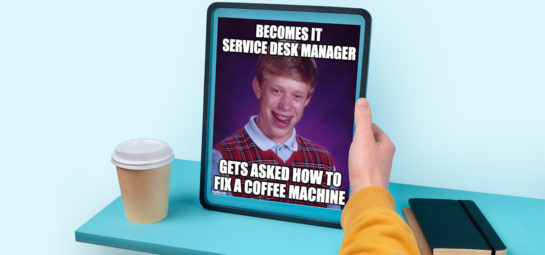What is swarming and how does it benefit your IT support?

Is your IT support team still following the traditional three-tiered support model to resolve tickets? While this method has its advantages—like efficient escalation and specialized solutions—it might not always be the best fit. Enter swarming, a collaborative approach that could revolutionize how your IT support operates.
What is swarming?
So, what is swarming? In the realm of IT support, swarming is a collaborative problem-solving method where multiple team members join forces to tackle complex issues in real-time. Unlike the traditional tiered approach—where an issue moves from Tier 1 to higher tiers if unresolved—swarming brings the right people together right away.
Instead of passing the problem up the chain and waiting at each level, swarming pools diverse expertise immediately. This means faster resolutions, more innovative solutions, and happier users. It's like assembling a superhero team to address a challenge head-on, rather than waiting for each hero to take a solo shot at it.
4 Benefits of swarming
Swarming offers several benefits for your IT support:
1. More transparency
With swarming, both your team and your users gain clear insight into the problem-solving process. Everyone can see who's involved and what's being done, which builds trust and keeps all parties informed.
2. Skill development
Collaborating on diverse issues allows team members to learn from each other. Junior staff can pick up new techniques from veterans, and even seasoned pros can gain fresh perspectives. It's a continuous learning environment.
3. Employee empowerment
By breaking down traditional hierarchies, swarming empowers everyone to contribute. Team members feel valued and heard, leading to increased motivation and job satisfaction.
4. Lower staff turnover
An engaging, inclusive work culture naturally leads to happier employees. When people feel part of a team and see the impact of their contributions, they're more likely to stick around.
Implementing swarming at your IT service desk
Ready to give swarming a shot? Here's how to start:
Step 1: see swarming as a culture rather than structure
Swarming isn't just a new process—it's a new mindset. Begin by fostering a culture that values curiosity, collaboration, and mutual support. Hire team members who are eager to learn and help others. Encourage open communication and make sure everyone understands the benefits of this approach.
Your existing employees will have to get used to a different way of working. Transitioning from a three-tiered system to swarming is a big shift for everyone. At first, your employees may struggle with greater autonomy. And that’s perfectly fine. You have to guide people to use their newfound freedom. Your employees have to learn to focus more on the customers, and less on “the rules.”
Step 2: change the way you use key metrics
Traditional support models often focus on service desk KPIs like call handling time or tickets closed. With swarming, it's time to shift your focus to customer satisfaction. Prioritize the quality of the support experience over sheer numbers. This means measuring success by happy users and effective resolutions, not just quick fixes.
This doesn’t mean some of your more traditional metrics aren’t relevant anymore. Just don’t use them to check on your employees or to push them. Instead, employ these metrics to constantly improve your IT support with customer satisfaction in mind. Use the same metrics but focus on customer experience rather than employee efficiency.
Best practices for successful swarming
To make the most of swarming, keep these tips in mind:
1. Encourage collaboration and knowledge sharing
Create an environment where team members feel comfortable sharing ideas and asking for help. Regular meetings, open discussions, and collaborative tools can facilitate this. The goal is to make collaboration the norm, not the exception.
2. Maintain clear communication channels
Effective swarming relies on everyone being on the same page. Use communication platforms that keep discussions organized and accessible. Whether it's a dedicated chat channel, video conferencing, or collaborative software, make sure your team can easily connect.
3. Continuously monitor and adjust processes based on feedback
Regularly seek feedback from both your team and your users. What's working well? Where are the bottlenecks? Use this information to refine your processes. Swarming is flexible by nature, so don't be afraid to adjust as you go.
Key metrics for measuring swarming success
To find out if swarming is truly benefiting your IT support, you'll want to focus on a few key areas. Start by looking at customer satisfaction scores. These scores give you a direct line into how users feel about the support they're receiving. If customers are happier, it's a good sign that swarming is enhancing their experience. Next, pay attention to how quickly issues are being resolved. When resolution times decrease, it indicates that swarming is making your team more efficient at tackling problems compared to the old way of doing things.
Don't forget about your team members. Regularly check in with them to gauge their engagement and get their feedback. If they feel motivated and enjoy the collaborative atmosphere that swarming creates, you're on the right track. By keeping an eye on these factors—customer satisfaction, resolution times, and employee engagement—you'll get a clear picture of how well swarming is working in your organization. This insight will help you understand what's going well and where you might need to make improvements to get even better results.
Swarming in action
But what does swarming look like in real life? A great example of swarming in action is highlighted in a case study involving Slack and Salesforce. In this scenario, companies successfully implemented swarming by integrating Slack's real-time communication platform with Salesforce's customer service tools. When a complex customer issue arose, support agents used Slack to instantly bring together the right experts from various departments. This immediate collaboration enabled the team to address the problem quickly and effectively, without the delays of traditional escalation.
The seamless integration between Slack and Salesforce facilitated transparent communication, efficient knowledge sharing, and a unified approach to problem-solving. This case study demonstrates how adopting swarming can lead to faster resolutions, higher customer satisfaction, and a more engaged support team, showcasing the tangible benefits of this collaborative method.
Knowledge management and swarming
Ready to transform your IT support with swarming? Knowledge management is a key part of swarming, so it’s time to break down those dreaded knowledge silos in your IT team first. Download our knowledge management guide to find out how sharing knowledge takes your IT support to the next level.
Inspire others, share this blog



